Transatlantic medical consultation and second opinion in pediatric cardiology has benefit past patient care: A case study in videoconferencing
Abstract
Background
Telemedicine is a rapidly evolving form of modern information and communication technology used to deliver clinical services and educational activities.
Objective
The aim of this article is to report and analyze our experience with transatlantic consultation via videoconferencing in pediatric cardiology.
Methods
In February, 2013, videoconferencing project was launched between a medium-volume pediatric cardiac center in Bratislava, Slovakia and subspecialty experts from a high-volume pediatric cardiac program at The Children's Hospital of Philadelphia (CHOP), USA. During 1.5–2 hours videoconferences, 2–3 patients with similar complex clinical scenarios were presented to CHOP experts. The main goal of the project was consultation on individual patients to validate, alter or radically change clinical management plans.
Results
From February, 2013 to January, 2017, 25 videoconferences occurred and 73 cases were discussed. The median patient age was 52 months (range; 1 day–30 years). Forty-six discussed cases were outpatients, 21 patients were in the intensive care unit and 6 patients were discussed post mortem. Thirty-one CHOP experts from different subspecialties participated actively in patient consultations. The most frequent recommendations were related to single ventricle, pulmonary hypertension or heart failure patients and intervention in complex and/or rare cardiac diseases. Specialists from CHOP agreed completely with the original care plan in 16% of cases. In 52% cases, adjustments to original plan were suggested. Radical changes were recommended in 30% of cases. Receiving institution adopted recommendations to the patient care fully in 79% and partially in 13% of patients.
Conclusions
Based on our 4-year experience we consider videoconferencing between medium-size pediatric cardiac center and subspecialty experts from a high-volume pediatric cardiac program a suitable form of medical consultations. Videoconferencing assists in clinical decision making for complex patient cases and serves as an effective educational tool to gain knowledge and experience “without borders.”




